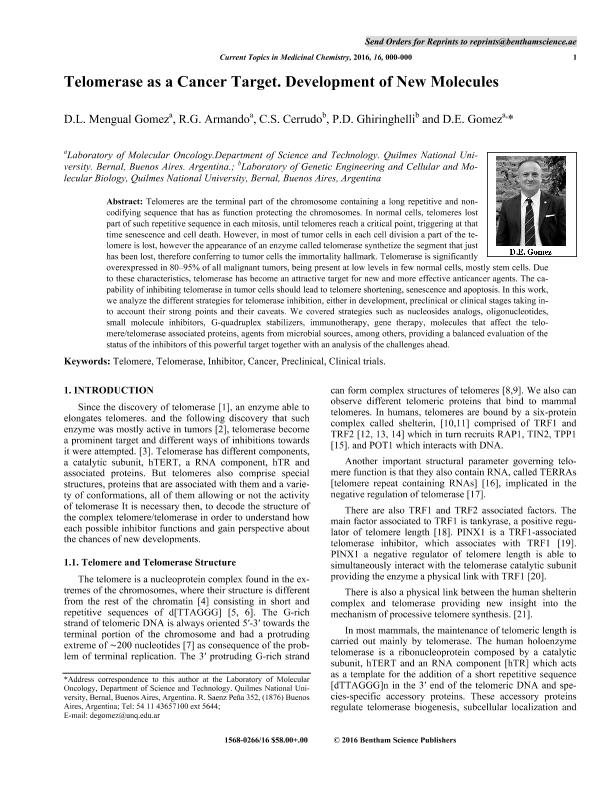Mostrar el registro sencillo del ítem
dc.contributor.author
Mengual Gómez, Diego Luis

dc.contributor.author
Armando, Romina Gabriela

dc.contributor.author
Cerrudo, Carolina Susana

dc.contributor.author
Ghiringhelli, Pablo Daniel

dc.contributor.author
Gomez, Daniel Eduardo

dc.date.available
2020-05-26T21:26:23Z
dc.date.issued
2002-10
dc.identifier.citation
Mengual Gómez, Diego Luis; Armando, Romina Gabriela; Cerrudo, Carolina Susana; Ghiringhelli, Pablo Daniel; Gomez, Daniel Eduardo; Telomerase as a cancer target. Development of new molecules; Cell Press; Cancer Cell; 2; 4; 10-2002; 257-265
dc.identifier.issn
1568-0266
dc.identifier.uri
http://hdl.handle.net/11336/105952
dc.description.abstract
Telomeres are the terminal part of the chromosome containing a long repetitive and non-codifying sequence that has as function protecting the chromosomes. In normal cells, telomeres lost part of such repetitive sequence in each mitosis, until telomeres reach a critical point, triggering at that time senescence and cell death. However, in most of tumor cells in each cell division a part of the telomere is lost, however the appearance of an enzyme called telomerase synthetize the segment that just has been lost, therefore conferring to tumor cells the immortality hallmark. Telomerase is significantly overexpressed in 80?95% of all malignant tumors, being present at low levels in few normal cells, mostly stem cells. Due to these characteristics, telomerase has become an attractive target for new and more effective anticancer agents. The capability of inhibiting telomerase in tumor cells should lead to telomere shortening, senescence and apoptosis. In this work, we analyze the different strategies for telomerase inhibition, either in development, preclinical or clinical stages taking into account their strong points and their caveats. We covered strategies such as nucleosides analogs, oligonucleotides, small molecule inhibitors, G-quadruplex stabilizers, immunotherapy, gene therapy, molecules that affect the telomere/telomerase associated proteins, agents from microbial sources, among others, providing a balanced evaluation of the status of the inhibitors of this powerful target together with an analysis of the challenges ahead.
dc.format
application/pdf
dc.language.iso
eng
dc.publisher
Cell Press

dc.rights
info:eu-repo/semantics/openAccess
dc.rights.uri
https://creativecommons.org/licenses/by-nc-sa/2.5/ar/
dc.subject
telomere
dc.subject
telomerase
dc.subject
inhibitor
dc.subject
cancer
dc.subject
preclinical
dc.subject
clinical trials
dc.subject.classification
Bioquímica y Biología Molecular

dc.subject.classification
Ciencias Biológicas

dc.subject.classification
CIENCIAS NATURALES Y EXACTAS

dc.subject.classification
Tecnologías que involucran la identificación de ADN, proteínas y enzimas, y cómo influyen en el conjunto de enfermedades y mantenimiento del bienestar

dc.subject.classification
Biotecnología de la Salud

dc.subject.classification
CIENCIAS MÉDICAS Y DE LA SALUD

dc.subject.classification
Bioquímica y Biología Molecular

dc.subject.classification
Medicina Básica

dc.subject.classification
CIENCIAS MÉDICAS Y DE LA SALUD

dc.title
Telomerase as a cancer target. Development of new molecules
dc.type
info:eu-repo/semantics/article
dc.type
info:ar-repo/semantics/artículo
dc.type
info:eu-repo/semantics/publishedVersion
dc.date.updated
2020-05-22T17:51:34Z
dc.identifier.eissn
1535-6108
dc.journal.volume
2
dc.journal.number
4
dc.journal.pagination
257-265
dc.journal.pais
Estados Unidos

dc.description.fil
Fil: Mengual Gómez, Diego Luis. Universidad Nacional de Quilmes. Departamento de Ciencia y Tecnología. Laboratorio de Oncología Molecular; Argentina. Consejo Nacional de Investigaciones Científicas y Técnicas; Argentina
dc.description.fil
Fil: Armando, Romina Gabriela. Universidad Nacional de Quilmes. Departamento de Ciencia y Tecnología. Laboratorio de Oncología Molecular; Argentina. Consejo Nacional de Investigaciones Científicas y Técnicas; Argentina
dc.description.fil
Fil: Cerrudo, Carolina Susana. Consejo Nacional de Investigaciones Científicas y Técnicas; Argentina. Universidad Nacional de Quilmes. Departamento de Ciencia y Tecnología. Laboratorio de Ingeniería Genética y Biología Molecular y Celular. Área Virus de Insectos; Argentina
dc.description.fil
Fil: Ghiringhelli, Pablo Daniel. Consejo Nacional de Investigaciones Científicas y Técnicas; Argentina. Universidad Nacional de Quilmes. Departamento de Ciencia y Tecnología. Laboratorio de Ingeniería Genética y Biología Molecular y Celular. Área Virus de Insectos; Argentina
dc.description.fil
Fil: Gomez, Daniel Eduardo. Consejo Nacional de Investigaciones Científicas y Técnicas; Argentina. Universidad Nacional de Quilmes. Departamento de Ciencia y Tecnología. Laboratorio de Oncología Molecular; Argentina
dc.journal.title
Cancer Cell

dc.relation.alternativeid
info:eu-repo/semantics/altIdentifier/url/https://www.cell.com/fulltext/S1535-6108(02)00159-9
dc.relation.alternativeid
info:eu-repo/semantics/altIdentifier/doi/http://dx.doi.org/10.1016/S1535-6108(02)00159-9
Archivos asociados
